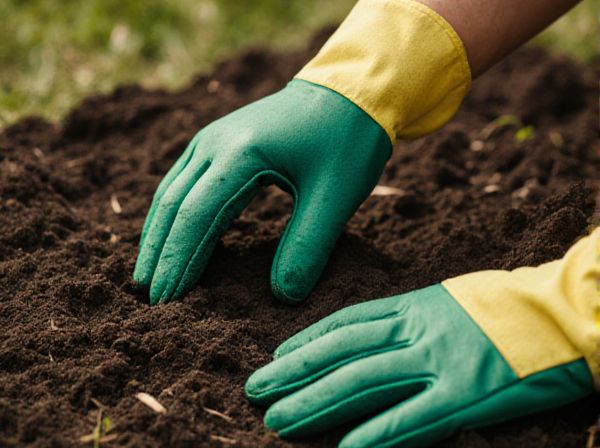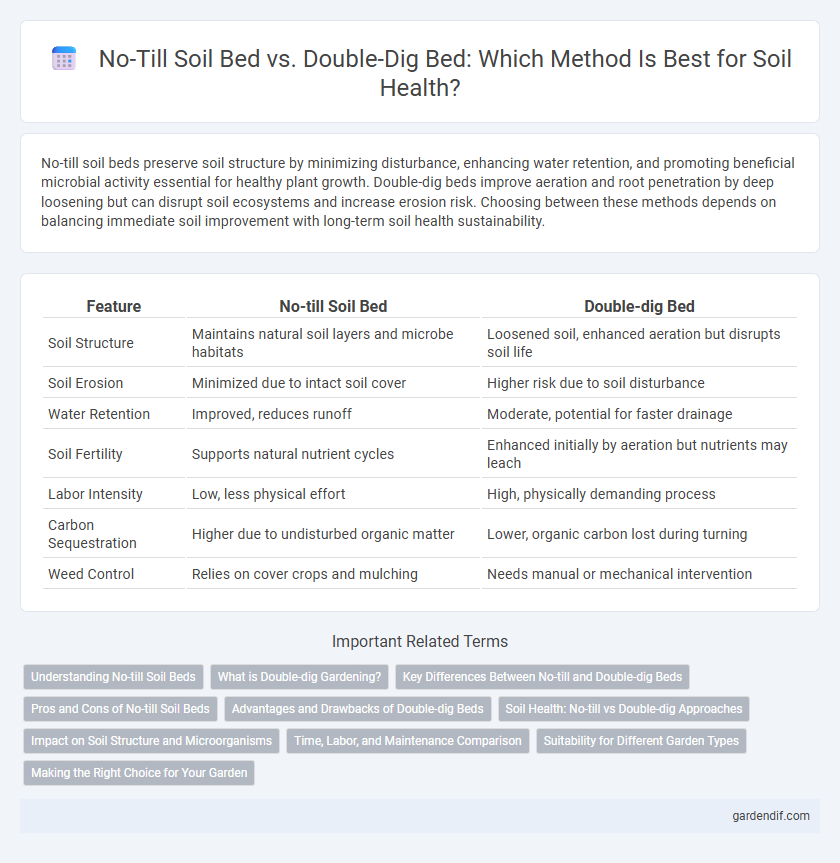
No-till Soil Bed vs Double-dig Bed Illustration
No-till soil beds preserve soil structure by minimizing disturbance, enhancing water retention, and promoting beneficial microbial activity essential for healthy plant growth. Double-dig beds improve aeration and root penetration by deep loosening but can disrupt soil ecosystems and increase erosion risk. Choosing between these methods depends on balancing immediate soil improvement with long-term soil health sustainability.
Table of Comparison
| Feature | No-till Soil Bed | Double-dig Bed |
|---|---|---|
| Soil Structure | Maintains natural soil layers and microbe habitats | Loosened soil, enhanced aeration but disrupts soil life |
| Soil Erosion | Minimized due to intact soil cover | Higher risk due to soil disturbance |
| Water Retention | Improved, reduces runoff | Moderate, potential for faster drainage |
| Soil Fertility | Supports natural nutrient cycles | Enhanced initially by aeration but nutrients may leach |
| Labor Intensity | Low, less physical effort | High, physically demanding process |
| Carbon Sequestration | Higher due to undisturbed organic matter | Lower, organic carbon lost during turning |
| Weed Control | Relies on cover crops and mulching | Needs manual or mechanical intervention |
Understanding No-till Soil Beds
No-till soil beds preserve soil structure, enhance microbial activity, and reduce erosion by avoiding mechanical disturbance. This method maintains organic matter and moisture retention, promoting healthier root systems and improved crop yields. Compared to double-dig beds, no-till beds require less labor and minimize soil compaction, supporting sustainable soil health.
What is Double-dig Gardening?
Double-dig gardening is a soil preparation technique that involves loosening two layers of soil, typically about 24 inches deep, to improve aeration, drainage, and root penetration. This method incorporates organic matter into the lower soil layers, enhancing nutrient availability and soil structure. Unlike no-till soil beds that preserve soil integrity by avoiding disturbance, double-digging requires significant manual effort but can boost plant growth in compacted or poor soils.
Key Differences Between No-till and Double-dig Beds
No-till soil beds maintain soil structure and microbial life by minimizing disturbance, promoting natural aeration and moisture retention, while double-dig beds involve manually loosening soil to a depth of 12-18 inches, enhancing root penetration and nutrient mixing. No-till beds reduce erosion and preserve organic matter, whereas double-dig beds accelerate nutrient availability through intensive soil turnover. The choice between these methods impacts soil health, labor intensity, and long-term productivity in garden and farm management.
Pros and Cons of No-till Soil Beds
No-till soil beds preserve soil structure, enhance microbial activity, and reduce erosion by leaving crop residues undisturbed, which improves long-term soil health and moisture retention. However, they can lead to increased reliance on herbicides for weed control and may require specialized equipment for planting. In contrast, double-dig beds loosen soil deeply, promoting root growth and rapid nutrient access but can disrupt soil microbial communities and increase labor intensity.
Advantages and Drawbacks of Double-dig Beds
Double-dig beds enhance soil aeration and nutrient availability by loosening deeper layers, promoting robust root growth and improved water infiltration. However, this method is labor-intensive, potentially disrupting soil structure and increasing erosion risk if not managed properly. Compared to no-till beds, double-digging may reduce microbial activity and organic matter retention, impacting long-term soil health.
Soil Health: No-till vs Double-dig Approaches
No-till soil beds preserve soil structure, organic matter, and microbial life by minimizing disturbance, leading to improved water retention and reduced erosion. Double-dig beds, while aerating soil and incorporating organic amendments, can disrupt soil microbes and diminish long-term soil aggregation if done frequently. Research shows no-till methods enhance soil health metrics such as microbial biomass and enzymatic activity compared to traditional double-dig practices.
Impact on Soil Structure and Microorganisms
No-till soil beds preserve soil structure by minimizing disturbance, thereby enhancing microbial diversity and activity crucial for nutrient cycling. In contrast, double-dig beds disrupt soil aggregates and microbial habitats but can temporarily increase aeration and root penetration. Long-term no-till practices promote stable soil organic matter and sustainable microbial ecosystems, while double-dig methods may lead to short-term gains at the expense of soil biota integrity.
Time, Labor, and Maintenance Comparison
No-till soil beds significantly reduce time and labor by eliminating the need for intensive digging, preserving soil structure and moisture while promoting natural microbial activity. Double-dig beds demand considerable physical effort and time to loosen soil deeply, which can disrupt soil ecosystems and require frequent maintenance to prevent compaction. Maintenance in no-till systems primarily involves managing surface residues and occasional organic inputs, whereas double-dig beds often need periodic reworking to sustain soil health and aeration.
Suitability for Different Garden Types
No-till soil beds are ideal for gardens aiming to preserve soil structure and microbial health, making them suitable for perennial or low-disturbance gardens. Double-dig beds enhance soil aeration and nutrient mixing, benefiting intensive vegetable gardens requiring frequent planting and deep root development. Choosing between these methods depends on the garden's crop rotation frequency, soil type, and long-term fertility management goals.
Making the Right Choice for Your Garden
No-till soil beds preserve soil structure and microbial life by minimizing disturbance, promoting long-term soil health and moisture retention. Double-dig beds enhance immediate aeration and nutrient access by deeply loosening soil layers, ideal for establishing new gardens or heavy clay soils. Selecting between no-till and double-dig methods depends on your garden's soil condition, crop requirements, and long-term sustainability goals.
No-till Soil Bed vs Double-dig Bed Infographic

 gardendif.com
gardendif.com